Vue新指令:v-slot
slot是Vue组件的一个重要机制,因为它使得完全解耦的组件之间可以灵活地被组合。在《Vue组件内容分发》和《Vue的作用域插槽》文章中我们深入的学习了slot怎么在Vue中的使用,但在Vue 3.0版本为slot引入了一套全新的模版语法。为了更好的从2.x过渡到3.0,Vue的v2.6版本引入了新的slot语法,即 v-slot。接下来我们来学习新指令v-slot的使用。
v-slot指令简介
在v2.6中,我们为具名插槽和作用域插槽引入了一个新的统一语法,即 v-slot。它取代了slot和slot-scope这两个目前已被废弃但未被移除且仍在文档中的特性。这是一个较重大的改变,主要包含了:
v-slot指令结合了slot和slot-scope的功能scoped slots的简写
有关于v-slot指令形成的讨论过程可以阅读RFC-0001和RFC-0002中的描述。
回顾slot的使用
从官网上我们可以获知,Vue中的slot主要分为:单个插槽、具名插槽和作用域插槽三种。而其使用也较为简单,比如我们有一个SlotDemo组件,可以在该组件中通过<slot>元素作为承载分发内容的出口:
<!-- SlotDemo.vue -->
<template>
<div class="slot">
<slot />
</div>
</template>
<script>
export default {
name: 'SlotDemo',
}
</script>
然后它允许你像下面这样使用SlotDemo组件,在使用该组件时,可以通过<slot>承载你想要的任何内容:
<!-- App.vue -->
<SlotDemo>
<div class="box">
<h1>Slot Demo</h1>
<p>This is slot demo!</p>
</div>
</SlotDemo>
渲染出来的内容可以看出,div.box中的内容替代了<slot>(也可以理解为该内容插入到了slot)中:
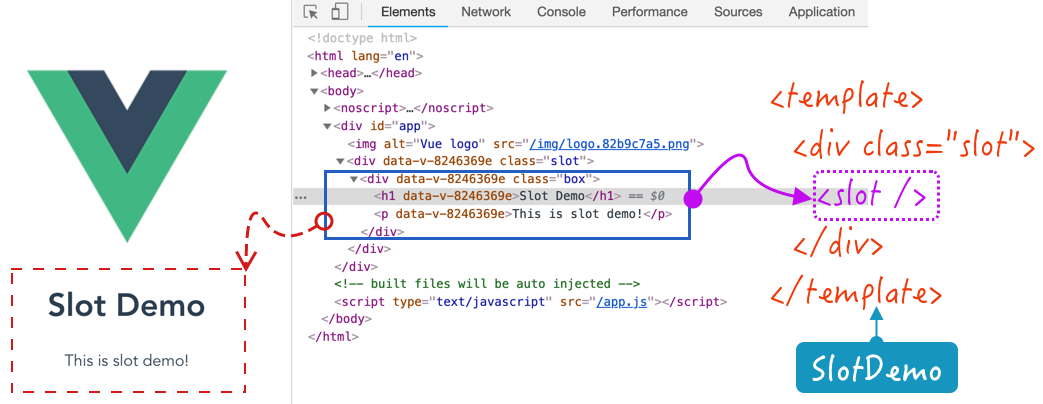
使用slot的时候,我们还可以为其设置一个默认的内容,也就是说没有提供内容的时候被渲染。比如下面这个SubmitButton组件中,默认情况下该按钮显示的文本内容是"提交",这个时候可以在<slot>标签内设置其内容为“提交”:
<!-- SubmitButton.vue -->
<template>
<button>
<slot>提交</slot>
</button>
</template>
<script>
export default {
name: 'SubmitButton',
}
</script>
当我们引用SubmitButton并不给slot插入任何内容时:
<!-- App.vue -->
<SubmitButton />
这个时候渲染出来的内容就是slot标签中的默认内容:
<button data-v-24449ecc="">提交</button>
如果我们想给按钮换成别的内容时,我们可以像下面这样使用:
<SubmitButton>保存</SubmitButton>
这个插入到slot中的内容“保存”会替代slot中默认的内容“提交”:
<button data-v-24449ecc="">保存</button>
最图如下图所示:
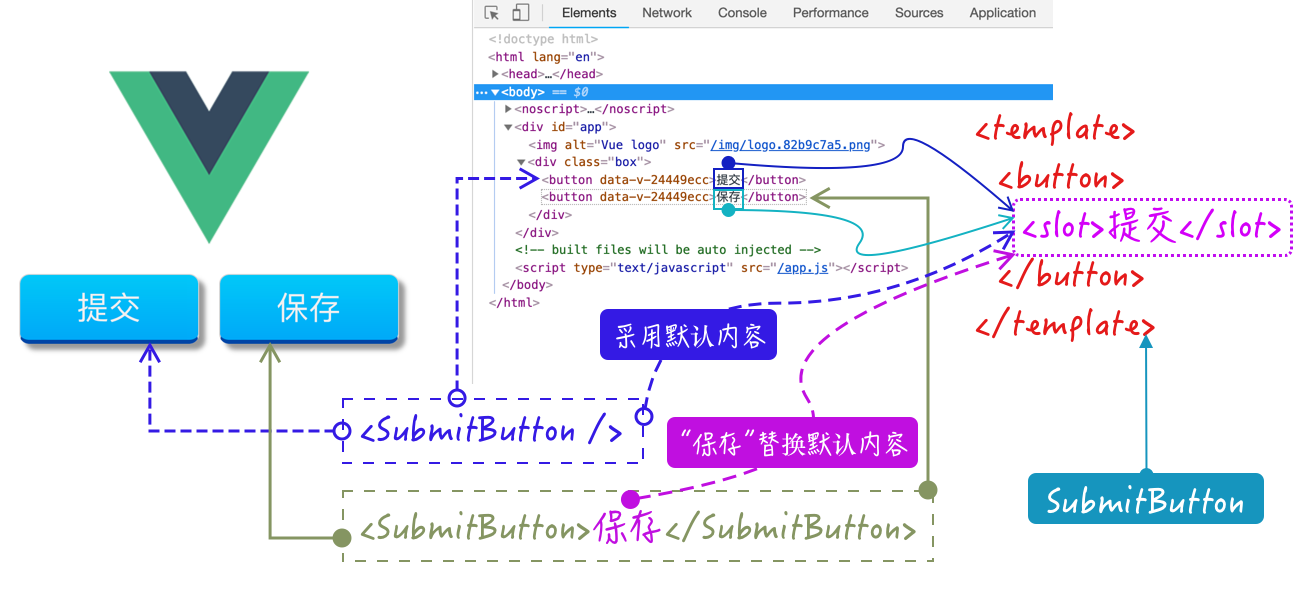
除了单个插槽之外,还可以使用 具名插槽,具名插槽的简单用法就是给slot显式的设置一个name值,比如下面这个BaseLayout组件:
<!-- BaseLayout.vue -->
<template>
<div class="container">
<header>
<slot name="header">我们希望把页头放在这里~</slot>
</header>
<main>
<slot>我们希望把主要内容放在这里</slot>
</main>
<footer>
<slot name="footer">我们希望把页脚放在这里</slot>
</footer>
</div>
</template>
<script>
export default {
name: 'BaseLayout',
}
</script>
调用具名插槽时,在对应的标签上使用slot="name",比如下面这个简单的用例:
<!-- App.vue -->
<BaseLayout>
<h1 slot="header">我是一个页头</h1>
<p slot="footer">©w3cplus</p>
</BaseLayout>

有关于Vue 2.6 版本之前
slot更详细的使用可以阅读早前的学习笔记 《Vue组件内容分发》。
slot还有另一个特性,那就是作用域插槽,用一个简单的示例来描述作用插槽的使用。先创建一个ColorList组件:
<!-- ColorList.vue -->
<template>
<div class="color-list">
<h2>{{ title }}</h2>
<div class="list">
<div class="list-item" v-for="(item, index) in items" :key="index">
<slot v-bind="item"></slot>
</div>
</div>
</div>
</template>
<script>
export default {
name: 'ColorList',
props: {
title: {
type: String,
default: 'Colors'
},
items: {
type: Array
}
}
}
</script>
<!-- App.vue -->
<template>
<div id="app">
<img alt="Vue logo" src="./assets/logo.png">
<ColorList :items="colors" title="Colors">
<template scope="color">
<div :style="{background: color.hex}">{{ color.name }}</div>
</template>
</ColorList>
</div>
</template>
<script>
import ColorList from './components/ColorList'
export default {
name: 'app',
components: {
ColorList
},
data () {
return {
colors: [
{ name: 'Yellow', hex: '#F4D03F', },
{ name: 'Green', hex: '#229954' },
{ name: 'Purple', hex: '#9B59B6' }
]
}
}
}
</script>
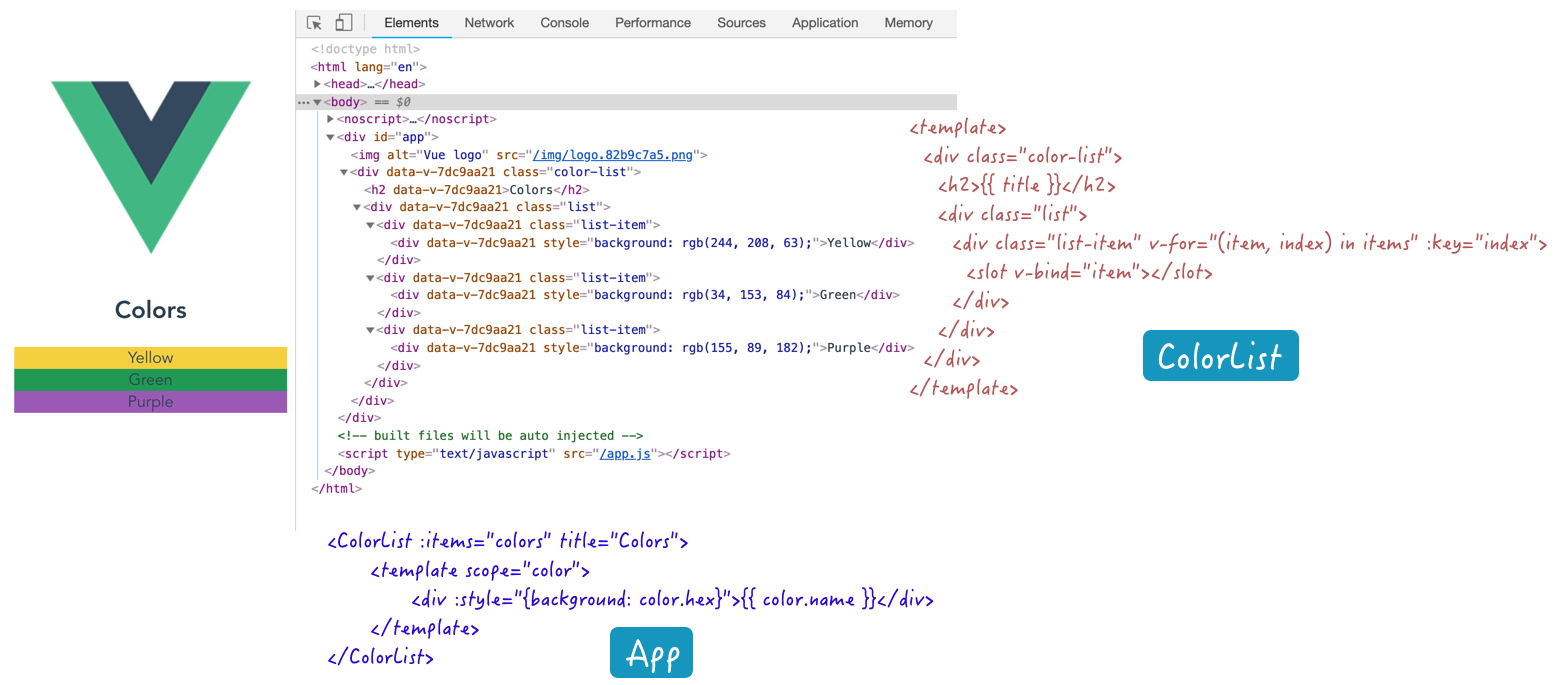
有关于 Vue 2.6 之前作用域插槽更详细的介绍可以阅读早前整理的《Vue的作用域插槽》一文。
上面示例涉及到的Demo代码,可以从[app-v-slot](//github.com/vuedemos/app-v-slot)中的step1分支中获取。
v-slot的使用
前面再次回顾了Vue 2.6版本之前的slot的使用,知道Vue中的slot主要有单个插槽、具名插槽和作用域插槽三种。在Vue 2.6版本起对slot有所更新,已经废弃了 slot和slot-scope 特性。从字面面上的理解就是Vue之后slot和slot-scope语法有所更改。自己在V3.0.1版本中亲测下面的使用(step1也是基于该版本测试的),但接下来,主要看v-slot的使用。
同样先来看单个插槽,即没有在<slot>标签中显式的设置name值。比如SlotDemo这个组件:
<!-- SlotDemo.vue -->
<template>
<div class="slot-demo">
<slot>我是一个slot</slot>
</div>
</template>
正如前面所述,slot标签中并没有显式设置name值,而且在slot标签中提供了一个默认的内容。我们在使用该组件时,可以通过v-slot:default来调用未显式设置name的slot:
<!-- App.vue -->
<template>
<div id="app">
<img alt="Vue logo" src="./assets/logo.png">
<SlotDemo />
<SlotDemo v-slot:default>
<p>v-slot:default 的使用</p>
</SlotDemo>
</div>
</template>
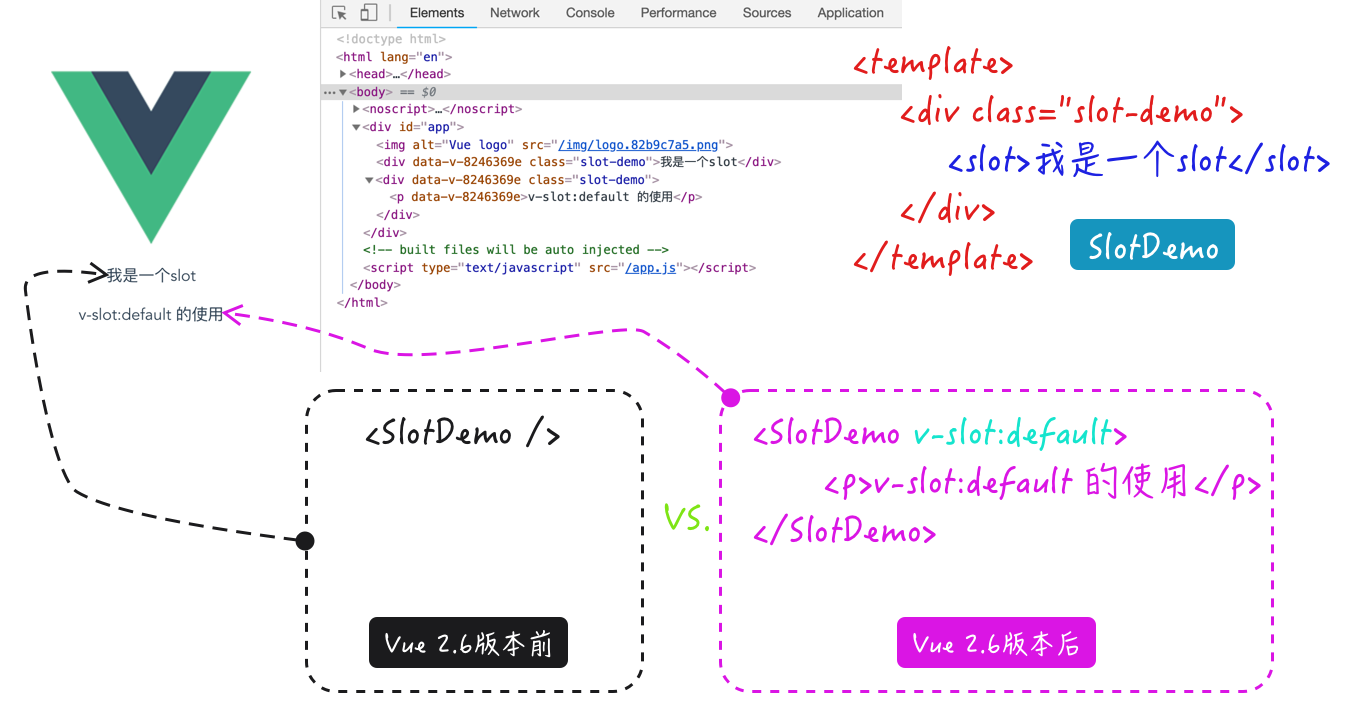
但一般建议v-slot:default添加到<template>上:
<!-- App.vue -->
<SlotDemo>
<template v-slot:default>
<h3>v-slot:default</h3>
</template>
</SlotDemo>
同样能正常的渲染出我们预期的结果。
一个不带
name的<slot>出口会带有隐含的名字default。
另外这里有一个特殊之处,当被提供的内容只有默认的插槽时,组件的标签上才可以被当作插槽的模板来使用,也就是说v-slot可以直接使用在组件上。正如上面的示例所示:
<SlotDemo v-slot:default>
<p>v-slot:default 的使用</p>
</SlotDemo>
接着来看一个具名插槽的示例,同样拿BaseLayout组件来举例:
<!-- BaseLayout.vue -->
<template>
<div class="container">
<header>
<slot name="header">Header Content</slot>
</header>
<main>
<slot>Main Content</slot>
</main>
<footer>
<slot name="footer">Footer Content</slot>
</footer>
</div>
</template>
<script>
export default {
name: 'BaseLayout'
}
</script>
在v2.6之后使用也是采用v-slot:
<!-- V2.6版本之前 具名插槽的使用 -->
<BaseLayout>
<h1 slot="header">Vue 2.6之前具名插槽</h1>
<p>我是页面的主内容</p>
<p slot="footer">©w3cplus</p>
</BaseLayout>
<!-- V2.6之后 具名插槽的使用 -->
<BaseLayout>
<template v-slot:header>
<h1>Vue 2.6之后具名插槽</h1>
</template>
<template v-slot:default>
<p>我是页面的主内容</p>
</template>
<template v-slot:footer>
<p>©w3cplus</p>
</template>
</BaseLayout>
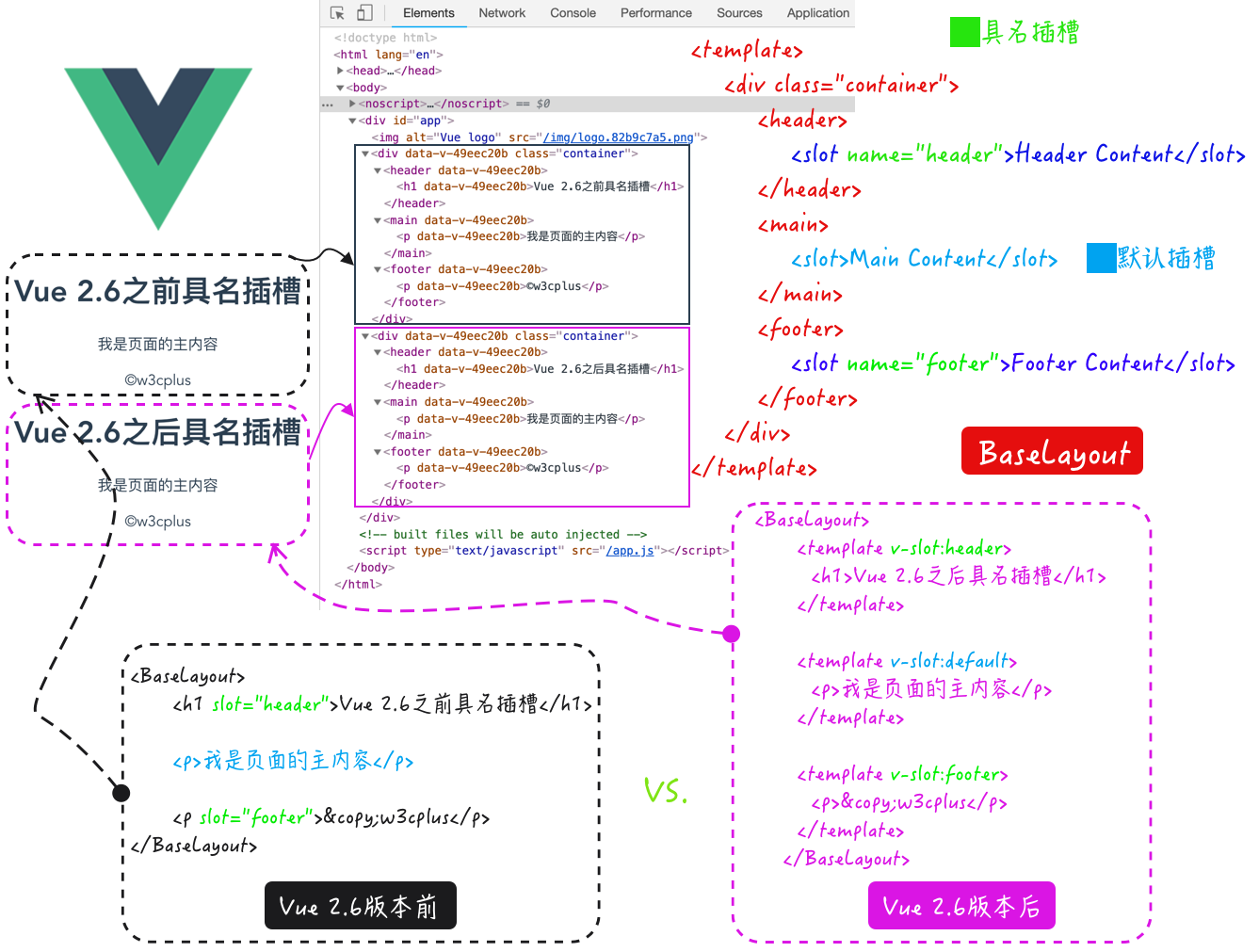
在<template>元素中的所有内容都会被传入相应的插槽中。另外,没有任何被包裹在带有v-slot的<template>中的内容都会被视为默认插槽的内容。然而,为了使用更具规范或明确一些,仍然可以在一个<template>中包裹默认插槽的内容,同时使用v-slot:default来表示。
v-slot和 v-on和v-bind类似,也可以缩写,即 把参数之前的所有内容(v-slot:)替换为字符 #。例如,上面的示例我们可以改写成:
<BaseLayout>
<template #header>
<h1>Vue 2.6之后具名插槽</h1>
</template>
<template #default>
<p>我是页面的主内容</p>
</template>
<template #footer>
<p>©w3cplus</p>
</template>
</BaseLayout>
接下来,我们再一起来看看作用域插槽中怎么来使用v-slot。同样拿一个List组件来举例,并且它暴露了一个过滤后的列表数据作为它的作用域插槽。
<!-- List.vue -->
<template>
<div class="list">
<div class="item" v-for="(item, index) in items" :key="index">
<slot v-bind="item" />
</div>
</div>
</template>
<script>
export default {
name: 'List',
props: {
items: {
type: Array,
}
}
}
</script>
我们可以这样来调用List组件:
<!-- App.vue -->
<!-- V2.6版本前 -->
<List :items="colors">
<template slot-scope="color" slot="default">
<div :style="{backgroundColor: color.hex}"> {{ color.name }}</div>
</template>
</List>
<!-- V2.6版本后 -->
<List :items="colors" v-slot="color">
<div :style="{backgroundColor: color.hex}"> {{ color.name }}</div>
</List>
<script>
import List from './components/List'
export default {
name: 'app',
components: {
List
},
data () {
return {
colors: [
{ name: 'Yellow', hex: '#F4D03F'},
{ name: 'Green', hex: '#229954' },
{ name: 'Purple', hex: '#9B59B6' }
]
}
}
}
</script>
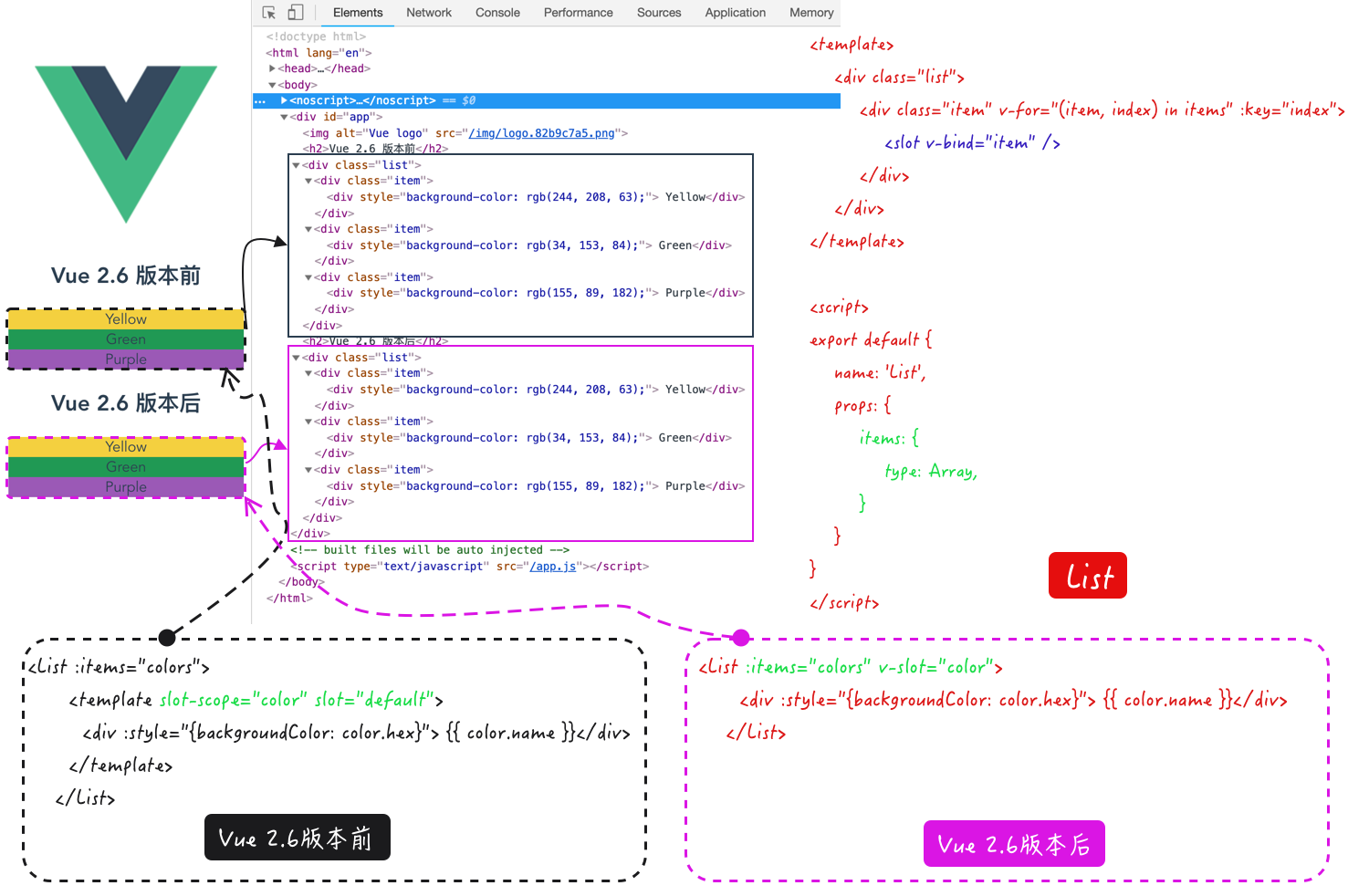
从示例上的代码可以看出,使用v-slot,避免了额外的嵌套。另外v-slot指令也提供了一个绑定 slot 和 scope-slot指令的方式,但需要使用一个 : 来分割它们。
有关于
v-slot示例的相关代码,可以把分支切换到step2。
小结
在 2.6.0 中,我们为具名插槽和作用域插槽引入了一个新的统一的语法 (即 v-slot 指令)。它取代了 slot 和 slot-scope 这两个目前已被废弃但未被移除且仍在文档中的特性。这篇文章主要介绍了Vue中slot新老语法两个版本的使用。希望对大家有所帮助。有关于更详细的介绍可以阅读 Vue官网提供的教程。
